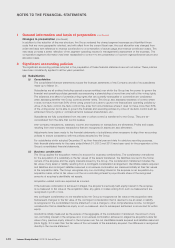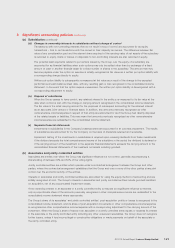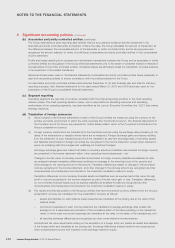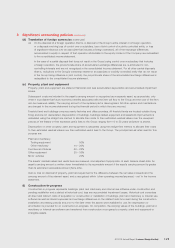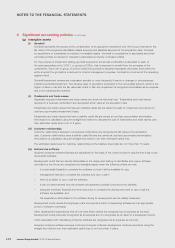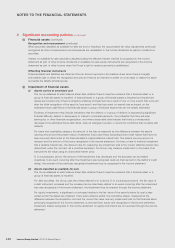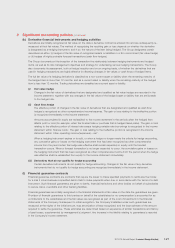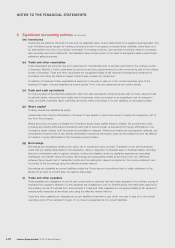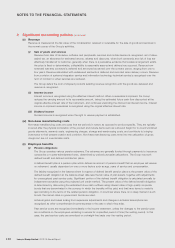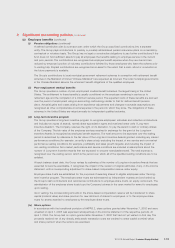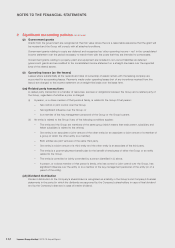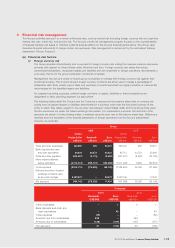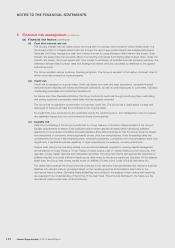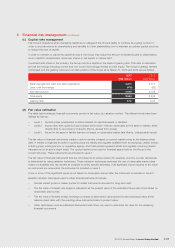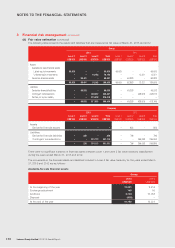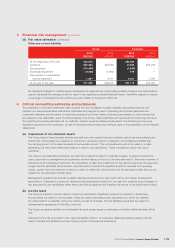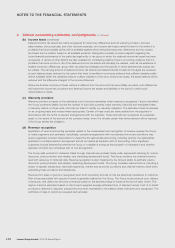Lenovo 2013 Annual Report Download - page 132
Download and view the complete annual report
Please find page 132 of the 2013 Lenovo annual report below. You can navigate through the pages in the report by either clicking on the pages listed below, or by using the keyword search tool below to find specific information within the annual report.
NOTES TO THE FINANCIAL STATEMENTS
Lenovo Group Limited 2012/13 Annual Report
130
2 Significant accounting policies (continued)
(v) Revenue
Revenue is measured at the fair value of the consideration received or receivable for the sale of goods and services in
the normal course of the Group’s activities.
(i) Sale of goods and services
Revenue from sale of hardware, software and peripherals, services and mobile devices is recognized, net of value-
added tax, an allowance for estimated returns, rebates and discounts, when both ownership and risk of loss are
effectively transferred to customer, generally when there is a persuasive evidence that a sales arrangement exists,
the price is fixed or determinable, collectability is reasonably assured and delivery has occurred. Revenue from
extended warranty contracts is deferred and amortized as earned over the contract period, ranging from one to
four years. Revenue associated with undelivered elements is deferred and recorded when delivery occurs. Revenue
from provision of systems integration service and information technology technical service is recognized over the
term of contract or when services are rendered.
The Group defers the cost of shipped products awaiting revenue recognition until the goods are delivered and
revenue is recognized.
(ii) Interest income
Interest income is recognized using the effective interest method. When a receivable is impaired, the Group
reduces the carrying amount to its recoverable amount, being the estimated future cash flow discounted at the
original effective interest rate of the instrument, and continues unwinding the discount as interest income. Interest
income on impaired receivables is recognized using the original effective interest rate.
(iii) Dividend income
Dividend income is recognized when the right to receive payment is established.
(w) Non-base manufacturing costs
Non-base manufacturing costs are costs that are periodic in nature as opposed to product specific. They are typically
incurred after the physical completion of the product and include items such as outbound freight for in-country finished
goods shipments, warranty costs, engineering charges, storage and warehousing costs, and contribute to bringing
inventories to their present location and condition. Non-base manufacturing costs enter into the calculation of gross
margin but are not inventoriable costs.
(x) Employee benefits
(i) Pension obligations
The Group operates various pension schemes. The schemes are generally funded through payments to insurance
companies or trustee-administered funds, determined by periodic actuarial calculations. The Group has both
defined benefit and defined contribution plans.
A defined benefit plan is a pension plan which defines an amount of pension benefit that an employee will receive
on retirement, usually dependent on one or more factors such as age, years of service and compensation.
The liability recognized in the balance sheet in respect of defined benefit pension plans is the present value of the
defined benefit obligation at the balance sheet date less the fair value of plan assets, together with adjustments
for unrecognized past service costs. Significant portion of the defined benefit obligation is calculated annually by
independent actuaries using the projected unit credit method. The present value of the defined benefit obligation
is determined by discounting the estimated future cash outflows using interest rates of high-quality corporate
bonds that are denominated in the currency in which the benefits will be paid, and that have terms to maturity
approximating to the terms of the related pension obligation. In countries where there is no deep market in such
bonds, the market rates on government bonds are used.
Actuarial gains and losses arising from experience adjustments and changes in actuarial assumptions are
recognized as other comprehensive income/expense in the year in which they arise.
Past service costs are recognized immediately in the income statement, unless the changes to the pension plan
are conditional on the employees remaining in service for a specified period of time (the vesting period). In this
case, the past service costs are amortized on a straight-line basis over the vesting period.


